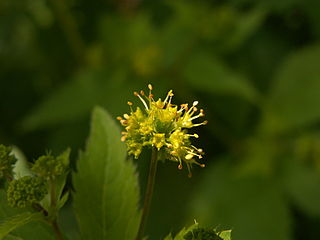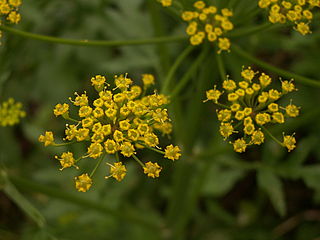Umbelliferae or Apiaceae
The parsley or carrot family includes ancestors of
some of our most common garden vegetables. It also
includes some of our most deadly poisons.
Hydrocotyle sibthorpioides
Hydrocotyle americana
Sanicula marilandica
 Clustered Black Snakeroot
(Sanicula gregaria). Greenish-yellow
flowers with very long (in proportion to the flower)
stamens and lower leaves with five roughly equal
leaflets are distinguishing marks. Other species of
Black Snakeroot around here have white flowers and
compound leaves with the lower pair of leaflets split
almost to the base.
Clustered Black Snakeroot
(Sanicula gregaria). Greenish-yellow
flowers with very long (in proportion to the flower)
stamens and lower leaves with five roughly equal
leaflets are distinguishing marks. Other species of
Black Snakeroot around here have white flowers and
compound leaves with the lower pair of leaflets split
almost to the base.
Sanicula trifoliata
Sanicula canadensis
Chaerophyllum procumbens
 Sweet
Cecily (Osmorhiza claytonii). A small
relative of Queen Anne’s Lace, this one grows in the
woods and bears its few-flowered umbels in spring. The
fuzzy fern-like leaves are distinctive. A similar
species, O. longistylis, is not hairy, and
thus easy to distinguish.
Sweet
Cecily (Osmorhiza claytonii). A small
relative of Queen Anne’s Lace, this one grows in the
woods and bears its few-flowered umbels in spring. The
fuzzy fern-like leaves are distinctive. A similar
species, O. longistylis, is not hairy, and
thus easy to distinguish.
Osmorhiza longistylis
 Poison Hemlock (Conium maculatum).
This is the plant “by which criminals and philosophers
were put to death at Athens,” as Gray observes
with a humor as dry as an herbarium specimen.
Most notoriously, the juice killed Socrates. It’s a
European import that’s very common in Pittsburgh along
roadsides and at the edge of the woods. The plants
resemble their relative Queen Anne’s Lace (Daucus
carota), but are much taller, with looser
umbels borne profusely up and down the strong stems.
Often the main stem has a distinctive whitish bloom.
Poison Hemlock (Conium maculatum).
This is the plant “by which criminals and philosophers
were put to death at Athens,” as Gray observes
with a humor as dry as an herbarium specimen.
Most notoriously, the juice killed Socrates. It’s a
European import that’s very common in Pittsburgh along
roadsides and at the edge of the woods. The plants
resemble their relative Queen Anne’s Lace (Daucus
carota), but are much taller, with looser
umbels borne profusely up and down the strong stems.
Often the main stem has a distinctive whitish bloom.
 Golden Alexanders (Zizia
aurea). Also known as Early Meadow
Parsnip, this is like a cheery golden Queen Anne’s
Lace, with similar compound umbels of flowers, more
delicate than the similarly yellow Wild Parsnip
(Pastinaca sativa). It likes a damp open woods or
meadow.
Golden Alexanders (Zizia
aurea). Also known as Early Meadow
Parsnip, this is like a cheery golden Queen Anne’s
Lace, with similar compound umbels of flowers, more
delicate than the similarly yellow Wild Parsnip
(Pastinaca sativa). It likes a damp open woods or
meadow.
Cicuta maculata
Cryptotaenia canadensis
 Goutweed (Aegopodium podagraria).
This attractive plant came to us as a garden
perennial, but has made itself so much at home that it
is becoming a pest in some areas. Its spreading habit
makes it a useful ground cover, but it is almost
impossible to eradicate if it gets into a plot where
it’s not welcome, because, when it is pulled up or dug
out, a new plant will sprout from the tiniest bit of
rhizome left in the soil. Many garden forms have
variegated leaves, but those forms may bear seeds that
will grow into ordinary green-leaved Goutweed.
Goutweed (Aegopodium podagraria).
This attractive plant came to us as a garden
perennial, but has made itself so much at home that it
is becoming a pest in some areas. Its spreading habit
makes it a useful ground cover, but it is almost
impossible to eradicate if it gets into a plot where
it’s not welcome, because, when it is pulled up or dug
out, a new plant will sprout from the tiniest bit of
rhizome left in the soil. Many garden forms have
variegated leaves, but those forms may bear seeds that
will grow into ordinary green-leaved Goutweed.
Anethum graveolens
Thaspium trifoliatum
Angelica venenosa
 Wild Parsnip (Pastinaca
sativa). This is actually the same plant
as the garden parsnip, though not bred for flavor. It
is often found on roadsides and at the edge of the
woods, frequently growing almost as tall as a person.
Blooms in late Spring. The combination of tall, thick
stems and broad compound umbels of yellow flowers is
distinctive.
Wild Parsnip (Pastinaca
sativa). This is actually the same plant
as the garden parsnip, though not bred for flavor. It
is often found on roadsides and at the edge of the
woods, frequently growing almost as tall as a person.
Blooms in late Spring. The combination of tall, thick
stems and broad compound umbels of yellow flowers is
distinctive.
Heracleum maimum
 Queen Anne’s Lace (Daucus carota).
The ancestor of our common carrots and parsley, this
European import is everywhere. But that doesn’t make
it any less beautiful. The tiny off-white flowers are
carried in dense flat clusters (“compound umbels,” to
use botanical language, meaning that the whole cluster
is an umbel made up of umbels). You can often find a
single tiny purple floret in the center of the
cluster. Later, the umbels close up into a seed
cluster that strongly resembles a bird’s nest. A purple
form, with all purple and white bicolored
flowers, is rare.
Queen Anne’s Lace (Daucus carota).
The ancestor of our common carrots and parsley, this
European import is everywhere. But that doesn’t make
it any less beautiful. The tiny off-white flowers are
carried in dense flat clusters (“compound umbels,” to
use botanical language, meaning that the whole cluster
is an umbel made up of umbels). You can often find a
single tiny purple floret in the center of the
cluster. Later, the umbels close up into a seed
cluster that strongly resembles a bird’s nest. A purple
form, with all purple and white bicolored
flowers, is rare.
 Clustered Black Snakeroot
(Sanicula gregaria). Greenish-yellow
flowers with very long (in proportion to the flower)
stamens and lower leaves with five roughly equal
leaflets are distinguishing marks. Other species of
Black Snakeroot around here have white flowers and
compound leaves with the lower pair of leaflets split
almost to the base.
Clustered Black Snakeroot
(Sanicula gregaria). Greenish-yellow
flowers with very long (in proportion to the flower)
stamens and lower leaves with five roughly equal
leaflets are distinguishing marks. Other species of
Black Snakeroot around here have white flowers and
compound leaves with the lower pair of leaflets split
almost to the base.
 Poison Hemlock (Conium maculatum)
Poison Hemlock (Conium maculatum) Golden Alexanders (Zizia
aurea)
Golden Alexanders (Zizia
aurea) Goutweed (Aegopodium podagraria)
Goutweed (Aegopodium podagraria) Wild Parsnip (Pastinaca
sativa)
Wild Parsnip (Pastinaca
sativa) Queen Anne’s Lace (Daucus carota)
Queen Anne’s Lace (Daucus carota)